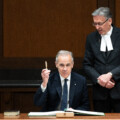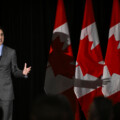In The Weekly Wrap Sean Speer, our editor-at-large, analyses for Hub subscribers the big stories shaping politics, policy, and the economy in the week that was.
The Weekly Wrap typically covers three issues or topics from the previous week. But this week there were two stories (besides U.S. President Joe Biden’s debate “fiasco”) that stood out: the Conservative victory in the Toronto—St. Paul’s by-election and game seven of the Stanley Cup final.
Are we seeing the start of a major political transformation?
There’s much to say about this week’s Conservative victory in the Toronto—St. Paul’s by-election. A lot of it—particularly the implications for Prime Minister Trudeau and the Liberal Party—has already been said here at The Hub and elsewhere. I think the most interesting part of the by-election outcome is the potential Conservative gains in cities and their upsides and downsides in the context of a possible Conservative government.
Darrell Bricker, who I think is Canada’s most insightful political commentator, has said that Canadian elections are decided by suburban voters who in any given election have to determine whether their issues and interests have more in common with rural voters, in which case they vote for Conservatives, or urban voters, in which they vote for Liberals. This week’s by-election signaled a world in which urban voters side with suburban and rural voters in favour of the Conservatives. The consequences could be huge.
The most obvious implication is that it creates the potential for one of the biggest majority governments that we’ve seen in decades. There’s been a prevailing assumption that our fragmented party system had effectively put an end to big majority governments. In fact, there’s been a sense that we may be entering an era of frequent minority parliaments. Yet a Conservative coalition composed of voters from cities, suburbs, and rural areas would reshape the political map and possibly overcome the constraints of fragmentation. That the Conservative win in Toronto—St. Paul’s didn’t depend on the Liberals and NDP splitting the left-wing vote only reinforces this point.
This could be a big deal for the Conservative Party. Although the party has been consistently competitive since it was established in 2003, it has struggled to push up its public support outside of a narrow band between roughly 30 and 35 percent. Even the party’s majority government in 2011 was won with less than 40 percent of the popular vote. A general election victory that extends into cities would therefore be a major accomplishment for Pierre Poilievre and demonstrate that Canadian conservatism has the potential to aspire to a majority political proposition.
A big majority government presumably comes with more electoral legitimacy, and a stronger mandate and greater scope to enact ambitious policy reform. It’s not a coincidence that the majority governments of Brian Mulroney and Jean Chretien were our most ambitious in terms of policy reform over the past 40 years. That Canada once again faces serious economic and social challenges means that the timing is opportune for a strong majority government with an ambitious policy agenda and a high-risk tolerance.
But it also comes with some downsides. A bigger parliamentary caucus means that there’s a larger share of MPs outside of the cabinet. This creates the potential for tensions within the caucus as well as the prospects for political unrest. That a considerable number of MPs may come from typically non-Conservative ridings also means that there could be a wide divergence of views that includes some outside of conventional conservative orthodoxy. Managing these differences could be challenging—particularly on key conservative issues like defunding the CBC or reducing the budget deficit.
This is of course mere speculation at this stage. A lot can happen between now and the next federal election. It’s also a truism that a large parliamentary caucus is ultimately better than a small one. But this week’s Toronto—St. Paul’s by-election points to some interesting short- and long-run scenarios for the Conservative Party that have the potential to reshape Canadian politics.

Florida Panthers left wing Ryan Lomberg lifts the Stanley Cup trophy after Game 7 of the NHL hockey Stanley Cup Final, June 24, 2024, in Sunrise, Fla. Rebecca Blackwell/The Canadian Press.
Did Canada’s high taxes cost the country the Stanley Cup?
This week’s game 7 of the Stanley Cup finals was watched by one of the largest audiences in NHL history. And for good reason. It was a wonderful playoff year in which the league’s best players like Connor McDavid put on a spectacular show for nearly nine weeks.
The Florida Panthers’ ultimate victory over the Edmonton Oilers reflected their superstar talent and extraordinary team depth. In a hard salary cap context, the Panthers have stretched their scarce dollars further than any other team in the league. In simple terms, that’s why they’re this year’s Stanley Cup champions.
One way to think about the NHL in a world of a salary cap is that each team has a finite amount to spend on players. The aim therefore must be to extract as much surplus value from each player as possible. You need as many players as you can to outperform their contracts and few or none to underperform them. The best teams naturally have more players outperforming their contracts than poor teams.
There are analysts who estimate players’ values relative to their salaries. You can then sum them up and assess whether a team is extracting surplus value relative to their contracts or actually running an overall deficit. The aggregate sum is known as “contract efficiency.”
The Florida Panthers have been assessed two years in a row as the most efficient team in the league. They have several players outperforming their contracts, including superstar forward Matthew Tkachuk who at $9.5 million per year is estimated to produce the most surplus value by far of any player in the NHL.
There could be different explanations for why the Panthers have the highest contract efficiency. Maybe their management team is really effective at contract negotiations. Maybe the players are prepared to accept less money to play for the Panthers because they have a close-knit team. Or because they’re a Stanley Cup contender. Or maybe it’s because the weather in Florida is better than cities like Edmonton.
One factor though is that Florida doesn’t have a state income tax. Players’ take-home pay therefore is higher than those who play in high-tax jurisdictions and earn the same or even more. This is a huge advantage for the Panthers because they stretch their cap dollars further as a result.
Take Tkachuk for instance. One estimate is that though he earns $9.5 million per year, he actually produces value equivalent to a salary of $16.6 million. That means he’s providing $7.1 million annually in surplus value which is the equivalent of adding another top forward or defenceman.
Tkachuk can accept a lower salary in Florida because of the state’s tax advantage. The website Cap Friendly has an income tax calculator that enables one to estimate the tax costs and take-home pay of NHL salaries in different jurisdictions. It estimates that Tkachuk’s take-home pay in Florida is $5.8 million. A player earning the same $9.5 million on the Toronto Maple Leafs would have a take-home pay of $4.4 million. (To match Tkachuk, a Leafs player would need to earn $11 million per season.)
What these numbers tell us is that Canada’s personal income tax rates are highly uncompetitive relative to U.S. states. In fact, this week, University of Calgary economist Trevor Tombe produced analysis for The Hub that showed every Canadian province has a higher top personal income tax rate (combined federal-provincial) than any U.S. state (combined federal-state).
The risk, then, is that we’re not just losing good hockey players or even the Stanley Cup to teams in low-tax jurisdictions but we’re seeing doctors, lawyers, and other high-skilled professionals relocate to the United States. Last year, for instance, we saw the largest outmigration to the U.S. in more than a decade. Low-tax states like Florida and Texas were among the biggest recipients of these Canadian migrants.
Lowering taxes on high-income earners may be tough politics in our current populist moment. But there are opportunity costs to Canada’s high top tax rates. One of them may be that the Stanley Cup will remain on the U.S. side of the border for another season.









